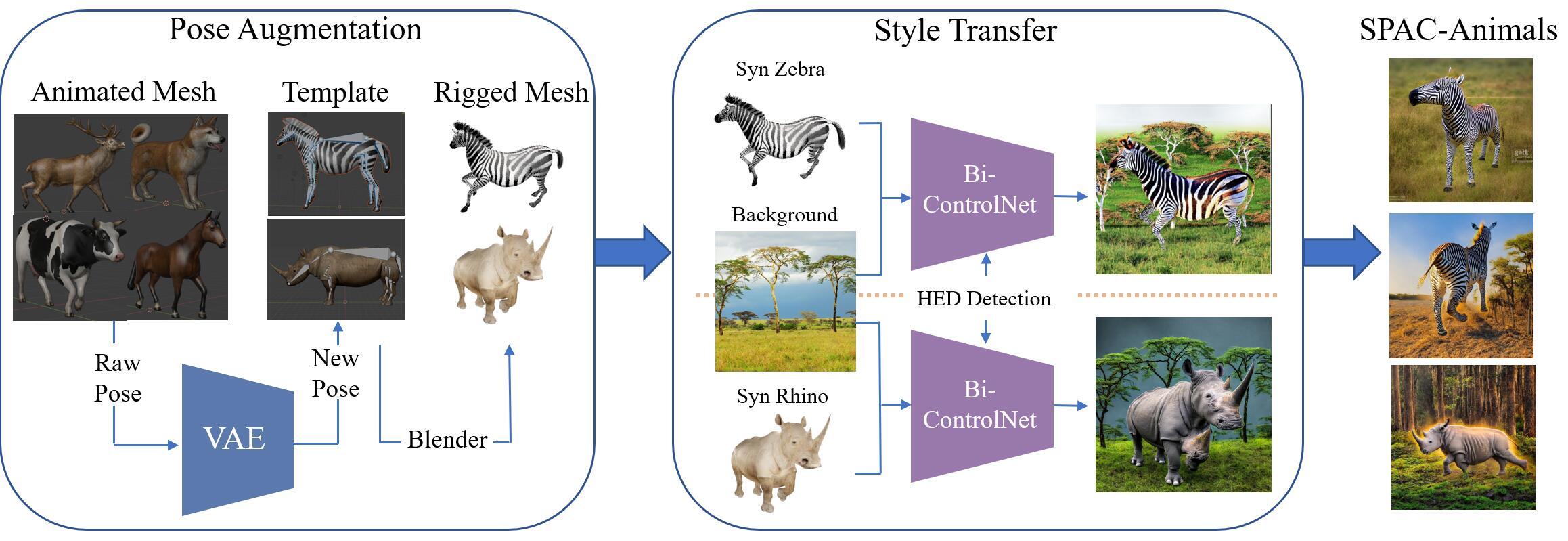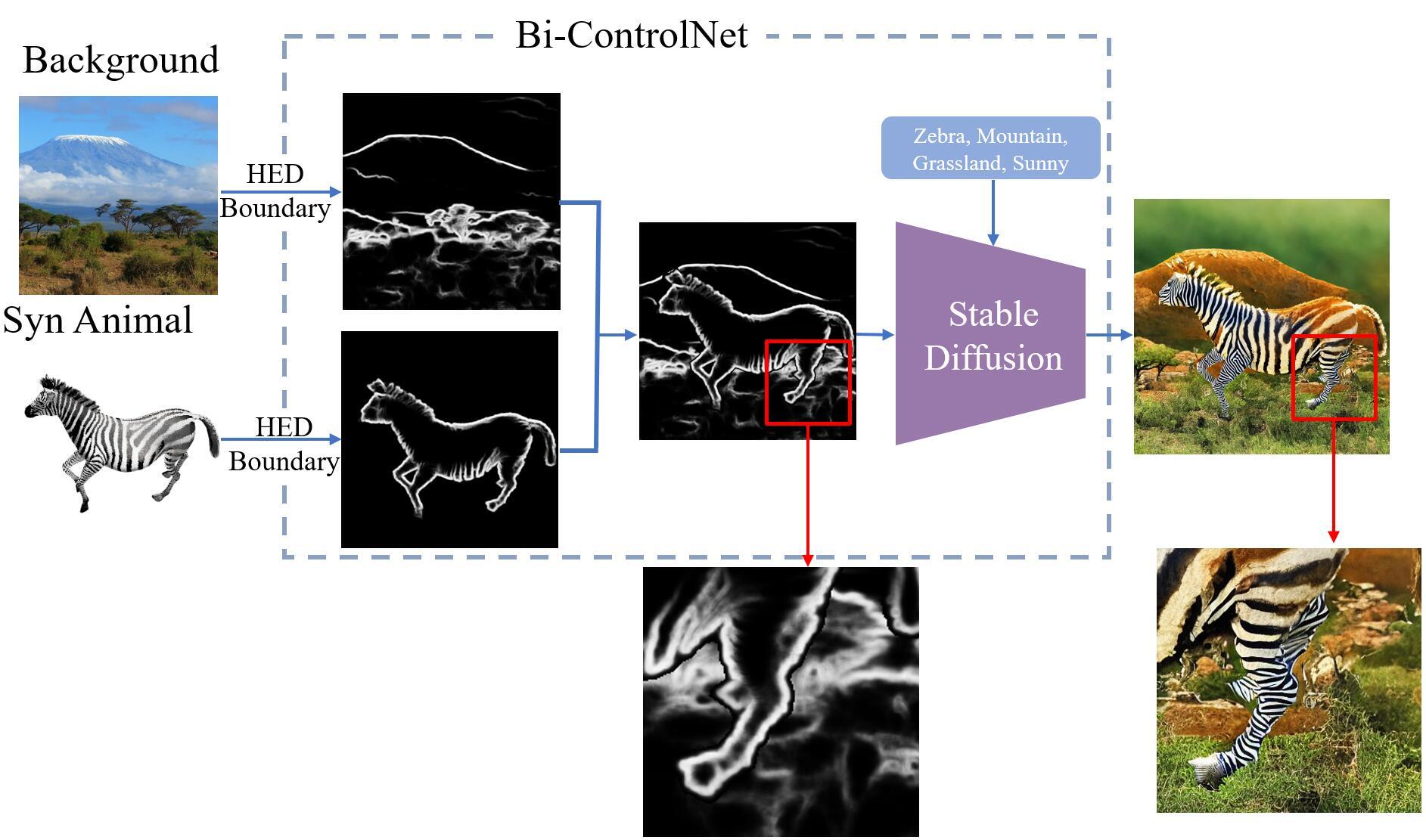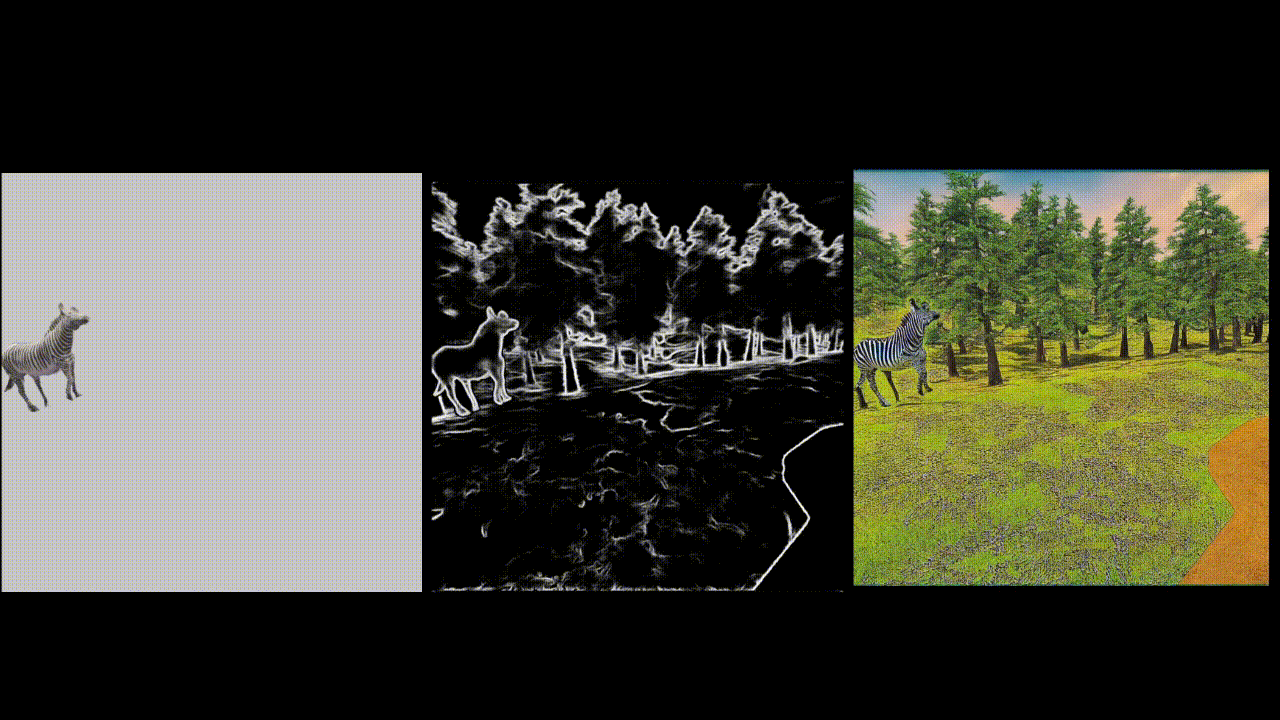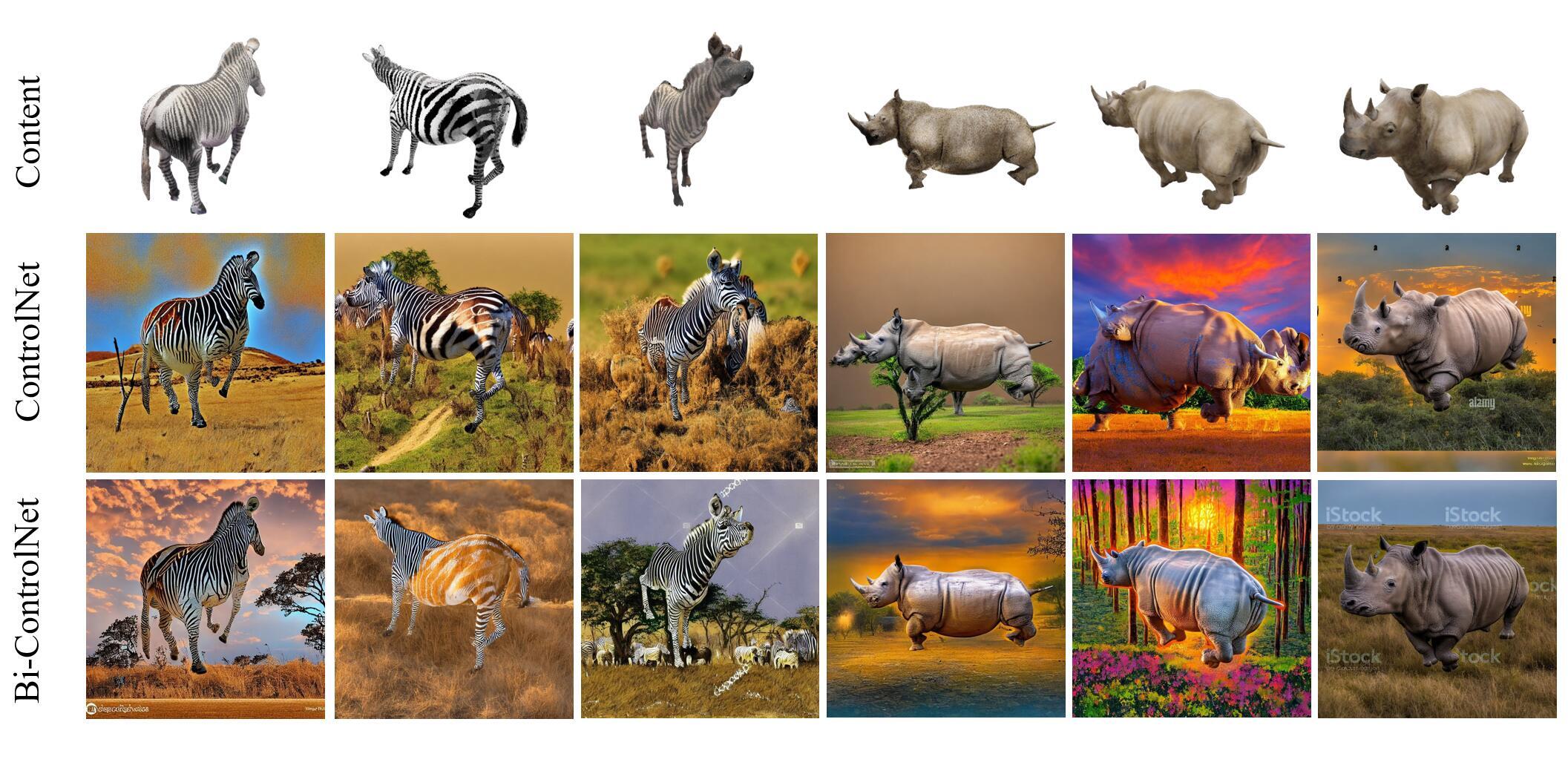Authors: Le Jiang, Sarah Ostadabbas
Introduction | Framework | Main Results | Experiment | Acknowledgments
This repository is the official repository of SPAC-Net: Synthetic Pose-aware Animal ControlNet for Enhanced Pose Estimation. In this work, we present a new approach called Synthetic Pose-aware Animal ControlNet (SPAC-Net), which incorporates ControlNet into the previously proposed Prior-Aware Synthetic animal data generation (PASyn) pipeline. We leverage the plausible pose data generated by the Variational Auto-Encoder (VAE)-based data generation pipeline as input for the ControlNet Holistically-nested Edge Detection (HED) boundary task model to generate synthetic data with pose labels that are closer to real data, making it possible to train a high-precision pose estimation network without the need for real data. In addition, we propose the Bi-ControlNet structure to separately detect the HED boundary of animals and backgrounds, improving the precision and stability of the generated data. An overview architecture of our synthetic prior-aware animal ControlNet (SPAC-Net), composed of three parts: pose augmentation,
style transfer and dataset generation. The SPAC-Net pipeline leads to generation of our probabilistically-valid animal
SPAC-Animals dataset.
An overview architecture of our synthetic prior-aware animal ControlNet (SPAC-Net), composed of three parts: pose augmentation,
style transfer and dataset generation. The SPAC-Net pipeline leads to generation of our probabilistically-valid animal
SPAC-Animals dataset.
 The Bi-ControlNet architecture, which separates the detection of the HED boundary for the background and the subject.
The Bi-ControlNet architecture, which separates the detection of the HED boundary for the background and the subject.
he effect of SPAC-Animals with limited real data of pose estimation results of the common backbones, HRNet-w32 tested on Zebra-300 and rhino-300
| Method | Training Set | Test Animal | Average | Eye | Nose | Neck | Shoulders | Elbows | F-Paws | Hips | Kness | B-Paws | RoT |
|---|---|---|---|---|---|---|---|---|---|---|---|---|---|
| MMPose | R(99) | Zebra | 78.7 | 97.3 | 95.8 | 83.2 | 78.8 | 77.1 | 62.6 | 86.0 | 74.9 | 59.8 | 82.4 |
| MMPose | R(99)+AP10K(8K) | Zebra | 91.4 | 97.5 | 97.2 | 79.4 | 87.8 | 90.3 | 93.8 | 95.3 | 94.1 | 89.5 | 86.4 |
| MMPose | R(99)+SynAP(3K) | Zebra | 92.4 | 97.8 | 98.3 | 81.1 | 94.0 | 93.5 | 92.0 | 93.7 | 93.5 | 89.0 | 87.6 |
| MMPose | R(99)+SPAC(3K) | Zebra | 96.3 | 97.8 | 96.5 | 93.4 | 98.4 | 95.5 | 92.9 | 98.2 | 96.9 | 95.7 | 97.2 |
| MMPose | R(99) | Rhino | 88.3 | 93.1 | 99.7 | 77.0 | 93.8 | 91.0 | 86.5 | 84.2 | 92.9 | 72.3 | 97.0 |
| MMPose | R(99)+AP10K(8K) | Rhino | 96.7 | 98.1 | 98.6 | 82.4 | 98.6 | 97.8 | 97.9 | 93.5 | 98.5 | 98.6 | 98.5 |
| MMPose | R(99)+SynAP(3K) | Rhino | 95.9 | 99.6 | 99.7 | 83.4 | 98.4 | 97.3 | 96.4 | 93.7 | 96.2 | 94.5 | 97.7 |
| MMPose | R(99)+SPAC(3K) | Rhino | 95.9 | 99.7 | 98.0 | 81.8 | 97.5 | 96.4 | 97.1 | 94.2 | 96.5 | 96.2 | 98.5 |
| Method | Training Set | Test Animal | Average | Eye | Nose | Neck | Shoulders | Elbows | F-Paws | Hips | Kness | B-Paws | RoT |
|---|---|---|---|---|---|---|---|---|---|---|---|---|---|
| MMPose | R(99) | Zebra | 97.3 | 95.8 | 83.2 | 78.8 | 77.1 | 62.6 | 86.0 | 74.9 | 59.8 | 82.4 | 78.7 |
| MMPose | Simple(3K) | Zebra | 30.7 | 19.9 | 31.1 | 48.0 | 34.1 | 36.4 | 41.9 | 38.3 | 34.0 | 45.6 | 36.7 |
| MMPose | SynAP(3K) | Zebra | 47.1 | 39.9 | 36.0 | 64.7 | 38.9 | 27.9 | 55.4 | 52.9 | 38.0 | 61.6 | 46.6 |
| MMPose | ControlNet(3K) | Zebra | 88.8 | 81.8 | 53.1 | 78.2 | 62.8 | 58.1 | 67.6 | 76.6 | 73.0 | 66.4 | 70.9 |
| MMPose | Bi-ControlNet(3K) | Zebra | 84.7 | 73.4 | 78.3 | 89.4 | 78.1 | 62.6 | 91.4 | 83.5 | 68.4 | 94.8 | 80.4 |
| MMPose | R(99) | Rhino | 93.1 | 99.7 | 77.0 | 93.8 | 91.0 | 86.5 | 84.2 | 92.9 | 72.3 | 97.0 | 88.3 |
| MMPose | Simple(3K) | Rhino | 33.2 | 28.4 | 30.1 | 28.4 | 18.0 | 14.7 | 50.0 | 38.1 | 22.8 | 47.0 | 29.9 |
| MMPose | SynAP(3K) | Rhino | 83.3 | 78.7 | 68.6 | 71.9 | 55.8 | 40.3 | 83.8 | 70.2 | 35.9 | 87.2 | 64.9 |
| MMPose | ControlNet(3K) | Rhino | 68.3 | 67.3 | 66.6 | 72.4 | 59.4 | 51.1 | 81.2 | 69.2 | 51.7 | 81.2 | 65.8 |
| MMPose | Bi-ControlNet(3K) | Rhino | 80.6 | 77.3 | 72.0 | 85.0 | 67.1 | 46.0 | 91.1 | 77.3 | 46.3 | 86.8 | 71.5 |
To generate your own synthetic dataset, you need to first prepare some animal images as templates. In our work, we used
Blender to rig the animal CAD models and rendered a large number of animal template images (3,000 for each species). We provide
template images and annotations for two species, zebra_template and rhino_template. We also collected about 400 scenery images background from the internet to enrich the backgrounds of the synthetic
data. You can download them from here.
When running the code, simply place the template image folder under the test folder and the background folder in
the root folder.
python SPAC_hed2image.py
Please refer to README.md for Installation.
We provide synthetic images for two species, zebra and rhino, generated by SPAC-Net. You can download SPAC-Zebras
and SPAC-Rhinos from here.
The original 768x768 folder contains the generated original images, while the train 300x300 folder contains
the resized images used for training. Please note that the annotations correspond to the resized images. The format
of the data is as follows:
SPAC-Animals
├── annotations_99real
├── annotations_99real+3000syn
├── annotations_99real+3000syn
├── original 768x768
│── 0000.jpg
│── 0001.jpg
│── ...
|── train 300x300
For SynAp data, please download SynAP.zip from SynAP, which contains 3,000 synthetic zebra images and 3,600 synthetic images of 6 other animals, and
different way to split the dataset. For more information, please refer to README.md
To train on Synthetic dataset, please replace the annotations file ap10k-train-split1.json and ap10k-val-split1.json with the
annotations we provided in SPAC-Animals or SynAP dataset before you start the training. In this work, we trained the pose estimation model provided by AP10K
bash tools/dist_train.sh configs/animal/2d_kpt_sview_rgb_img/topdown_heatmap/ap10k/hrnet_w32_ap10k_256x256.py 1
- For zebra, please download
zebra-300.zipandzebra-zoo.zipfrom SynAP. - For rhino, please download
rhino-300.zipfrom
zebra-300/rhino-300
├── annotations
│── annotations.json
│── annotations.csv
├── crop
│── 000000030372.jpg
│── ...
├── raw
If you use our code, datasets or models in your research, please cite with:
@misc{jiang2023spacnet,
title={SPAC-Net: Synthetic Pose-aware Animal ControlNet for Enhanced Pose Estimation},
author={Le Jiang and Sarah Ostadabbas},
year={2023},
eprint={2305.17845},
archivePrefix={arXiv},
primaryClass={cs.CV}
}
@article{jiang2022prior,
title={Prior-Aware Synthetic Data to the Rescue: Animal Pose Estimation with Very Limited Real Data},
author={Jiang, Le and Liu, Shuangjun and Bai, Xiangyu and Ostadabbas, Sarah},
year={2022}
}
Thanks for the open-source
- AP-10K: A Benchmark for Animal Pose Estimation in the Wild, Hang Yu, Yufei Xu, Jing Zhang, Wei Zhao, Ziyu Guan, Dacheng Tao
- ControlNet: Adding Conditional Control to Text-to-Image Diffusion Models,Lvmin Zhang and Maneesh Agrawala
- SmplifyX: Expressive Body Capture: 3D Hands, Face, and Body from a Single Image, Pavlakos, Georgios and Choutas, Vasileios and Ghorbani, Nima and Bolkart, Timo and Osman, Ahmed A. A. and Tzionas, Dimitrios and Black, Michael J..
- This code is for non-commertial purpose only.
- For further inquiry please contact: Augmented Cognition Lab at Northeastern University: http://www.northeastern.edu/ostadabbas/

